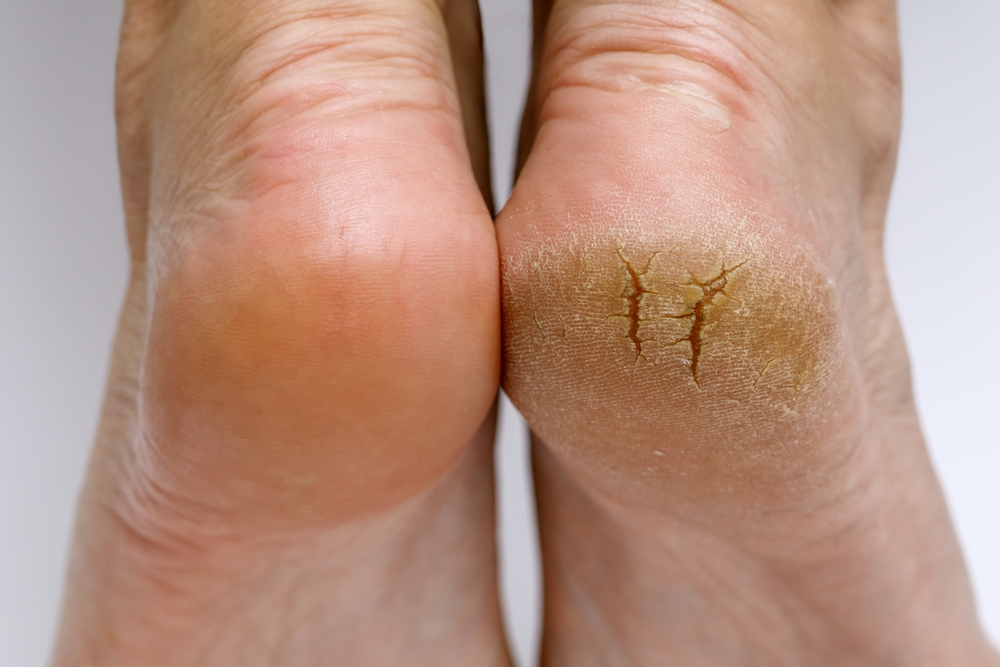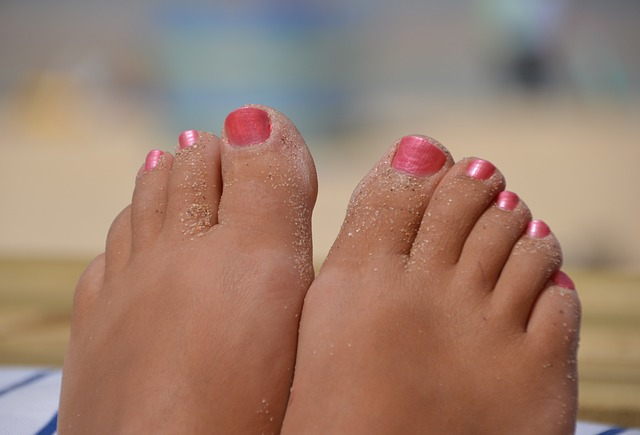Feet-Relief is supported by our audience. When you purchase through one of our links, we may earn a small affiliate commission. As an Amazon Associate I earn from qualifying purchases.Your cost is not affected.
Welcome to a comprehensive journey into a common concern that affects many individuals living with diabetes – the challenge of dealing with dry skin and cracks in diabetic feet. Diabetes, a widespread metabolic condition, touches the lives of millions worldwide. Amidst the various health considerations that diabetes brings, one often underestimated issue revolves around the skin, specifically the feet. Dry skin and cracks can bring discomfort and potential hazards for those with diabetes but fret not. With the right knowledge and care, you can proactively prevent and effectively manage these concerns. In this article, we’ll explore the causes, symptoms, and practical strategies to ensure the well-being of your diabetic feet, keeping them healthy and free from the complications associated with dry skin and cracks. So, join us on this engaging journey towards happier, healthier feet in the context of diabetes.
Preventing and Managing Dry Skin and Cracks in Diabetic Feet
Dry skin and cracks in diabetic feet can be a real pain, but they don’t have to be. In this article, we’ll explore the best ways to prevent and manage dry skin and cracks in diabetic feet, so you can keep your feet healthy and comfortable. From moisturizing tips to footwear recommendations, we’ve got you covered. So let’s get started!
Image Source: FreeImages
Skin Problems Caused by Diabetes
Diabetes, a condition affecting millions of people worldwide, is often associated with various skin issues. These problems range from minor irritations to severe conditions that require immediate medical attention. One of the most common, yet often overlooked, skin problems caused by diabetes is dry skin and cracks in the feet. This issue can lead to discomfort, infection, and difficulties in mobility if not properly managed.
The severity of skin problems caused by diabetes can vary greatly. Some people may experience minor dryness and cracking, while others may develop serious infections if the condition is left untreated. This makes understanding and early recognition of these skin issues crucial for people living with diabetes.
It’s also worth noting that skin problems are often one of the first visible signs of diabetes. Therefore, if you notice unusual changes to the skin on your feet, it’s important to consult a healthcare professional. They can provide an accurate diagnosis and recommend appropriate treatment options.
Understanding Dry Skin and Cracks in Diabetic Feet
Dry skin and cracks in diabetic feet are more than just a cosmetic issue. They can lead to serious complications if not properly managed. The skin on our feet serves as a barrier against bacteria and other external agents. When this barrier is compromised, it increases the risk of infection. In people with diabetes, this risk is even higher due to impaired immune function and poor blood circulation.
Cracks on diabetic feet, also known as fissures, can vary in depth and width. They can be superficial or deep, narrow or wide. These cracks occur when the skin becomes excessively dry and loses its elasticity, causing it to split. In severe cases, these fissures can extend into the dermis or even the subcutaneous tissue, leading to intense pain and increased risk of infection.
Dry, Itchy Skin
Dry skin in diabetic feet, on the other hand, is characterized by itching, scaling, and peeling. This condition, known as xerosis, contributes to the formation of cracks and fissures. It’s often a result of high blood glucose levels, which cause the body to lose fluids, leading to dehydration of the skin.
The Link Between Diabetes and Foot Skin Problems
Diabetes affects the body in numerous ways, and foot skin problems are one of the many complications that can arise from this condition. The high blood sugar levels characteristic of diabetes can lead to damage in various parts of the body, including the skin. This damage can result in a range of skin conditions, including dry skin and cracks on the feet.
Peripheral Neuropathy
One of the primary ways diabetes contributes to foot skin problems is through nerve damage, also known as neuropathy. This condition can lead to a loss of sensation in the feet, making it difficult for people with diabetes to notice when their feet are dry or cracked. As a result, this diabetic nerve damage may progress without intervention, increasing the risk of complications.
Another factor linking diabetes and foot skin problems is poor circulation. Diabetes can cause blood vessels in the feet to narrow and harden, reducing blood flow to the area. This lack of adequate blood flow can prevent the skin from receiving the nutrients it needs to stay healthy and moist, leading to dryness and cracking.
Causes of Dry Skin and Cracks in Diabetic Feet
The causes of dry skin and cracks in diabetic feet are multifactorial and often interconnected. High glucose levels in the blood are a primary cause, as they can lead to dehydration and xerosis. Other factors include neuropathy, poor circulation, and the use of certain medications.
Neuropathy, or nerve damage, can reduce the ability to sweat, leading to dry skin. Furthermore, neuropathy can cause a loss of sensation, meaning individuals may not feel when their skin is dry and cracking, leading to a delay in treatment and potential complications.
Health Complications
Poor circulation, another common complication of diabetes, can also contribute to dry skin and cracks. When blood flow to the feet is reduced, the skin does not receive adequate nutrients and oxygen, leading to dryness and potential cracking.
Certain medications used to manage diabetes can also contribute to dry skin. Diuretics, for example, help the body eliminate excess fluids but can also dehydrate the skin.
How Diabetes Causes Cracked Heels and Dry Skin
Diabetes can lead to cracked heels and dry skin in several ways. High blood sugar levels can cause the body to lose fluid at a faster rate, leading to dehydration. This dehydration can affect the skin, causing it to become dry and prone to cracking.
Neuropathy, a common complication of diabetes, can also play a role in causing cracked heels and dry skin. Damaged nerves in the feet may lead to changes in the way sweat glands function, causing the skin to become dry. Moreover, the loss of sensation associated with neuropathy can make it difficult for individuals to realize when their skin is dry and cracking, leading to further damage.
Additionally, poor circulation, another common issue in individuals with diabetes, can affect the skin’s health. When blood flow to the feet is compromised, the skin may not receive the necessary nutrients to stay hydrated and healthy, leading to dryness and potential cracks.
Symptoms and Signs of Cracks on Diabetic Feet
The symptoms and signs of cracks in diabetic feet can vary depending on the severity of the condition. However, some common indications include hard, thick skin around the heel, dry or flaky skin, red or flaky patches, and pain or discomfort when walking. In severe cases, bleeding or discharge from the cracks appears.
It is crucial to monitor your feet regularly if you have diabetes. Early detection of dry skin and cracks can prevent further complications. If you notice any changes, such as increased dryness, cracks, or other abnormalities, it is important to seek medical advice.
Prevention Tips for Dry Skin and Cracks in Diabetic Feet
Preventing dry skin and cracks in diabetic feet involves adopting a comprehensive foot care regimen. Regularly moisturizing your feet can help keep the skin hydrated and prevent dryness and cracking. Choose a moisturizer designed for dry skin, and avoid using it between your toes to prevent fungal infections.
It’s also important to keep your diabetes under control. High blood sugar levels can lead to dry skin, so managing your glucose levels can help prevent this. Regular exercise, a balanced diet, and taking medication as prescribed can all contribute to keeping your blood sugar levels in check.
Lastly, regular foot inspections can help detect any early signs of dry skin and cracks. Check your feet daily for any signs of changes or damage and promptly report any abnormalities to your healthcare provider.
Treatment Options to Treat Dry Skin Caused by Diabetes
There are various treatment options available to treat dry skin caused by diabetes. These range from over-the-counter products to prescription medications and therapies. Mild cases of dry skin can often be managed with a moisturizing cream or lotion designed for dry skin. These products help to hydrate the skin and restore its natural barrier function.
In more severe cases, a healthcare provider may recommend a prescription medication. This could include topical steroids to reduce inflammation or an antibiotic cream if an infection is present. It’s important to use these medications as directed and monitor your skin closely for any changes.
In addition to these treatments, lifestyle changes can also help to manage dry skin. This includes maintaining good control of your blood sugar levels, staying hydrated, and avoiding irritants such as harsh soaps and hot water.
Managing Cracked Heels Caused by Diabetes
Managing cracked heels caused by diabetes involves a combination of treatments and preventive measures. Regular use of a moisturizing cream or ointment can help to soften the skin and prevent further cracking. In more severe cases, a healthcare provider may recommend a keratolytic cream, which helps to break down the thick skin and promote healing.
Foot soaks can also be helpful in managing cracked heels. Soaking your feet in warm water for 15-20 minutes can help soften the skin and make it easier to remove dead skin with a foot file or pumice stone. However, it’s important not to soak your feet for too long as this can actually dry out the skin.
It’s also important to protect your feet. Avoid walking barefoot as this can further damage the skin and increase the risk of infection. Instead, wear comfortable, well-fitted shoes that provide adequate support and protection.
The Importance of Regular Foot Care in Diabetes
Regular foot care is crucial for individuals with diabetes. High blood sugar levels can lead to a number of foot problems, including dry skin and cracks, which can increase the risk of infection and other complications if not properly managed.
Regular foot inspections should be part of your daily routine. Check for any changes in the skin, such as dryness, cracking, or signs of infection. You should also look for any changes in the shape of your feet, as this could indicate a problem with your circulation or nerves.
Maintaining good foot hygiene is also important. Wash your feet daily with mild soap and warm water, and dry them thoroughly, especially between the toes. Moisturize your feet regularly to prevent dryness and cracking, but avoid applying moisturizer between the toes as this can lead to a fungal infection.
Video Credit: @RafflesHospital
Managing Cracked Heels Caused by Diabetes
Managing cracked heels caused by diabetes involves a combination of treatments and preventive measures. Regular use of a moisturizing cream or ointment can help to soften the skin and prevent further cracking. In more severe cases, a healthcare provider may recommend a keratolytic cream, which helps to break down the thick skin and promote healing.
Foot soaks can also be helpful in managing cracked heels. Soaking your feet in warm water for 15-20 minutes can help soften the skin and make it easier to remove dead skin with a foot file or pumice stone. However, it’s important not to soak your feet for too long as this can actually dry out the skin.
It’s also important to protect your feet. Avoid walking barefoot as this can further damage the skin and increase the risk of infection. Instead, wear comfortable, well-fitted shoes that provide adequate support and protection.
When to Seek Professional Help for Foot Skin Problems Diabetes
While mild cases of dry skin and cracks can often be managed at home, it’s important to seek professional help if your symptoms persist or worsen. Signs that you should seek medical attention include deep or painful cracks, signs of infection such as redness, swelling, or pus, and any changes in the color or temperature of your feet.
It’s also important to seek professional help if you have any underlying conditions that could complicate your foot skin problems, such as poor circulation or nerve damage. Your healthcare provider can provide a comprehensive examination and recommend appropriate treatment options.
Avoiding Diabetic Foot Complications
It’s true, dry skin and cracks in diabetic feet are common issues that can lead to serious complications if not properly managed. However, with regular foot care, good diabetes control, and prompt treatment of any issues, these problems can be effectively managed.
Remember, the key to preventing and managing dry skin and cracks in diabetic feet is understanding the causes, recognizing the symptoms, and taking proactive steps to maintain the health of your feet. With the right care and attention, you can keep your feet healthy and avoid the complications associated with diabetes.
Taking Care of Your Diabetic Feet: Your Path to Healthier and Happier Feet
In our journey through the realm of diabetic foot care, we’ve delved deep into the concerns of dry skin and cracks that affect many individuals living with diabetes. We’ve uncovered the causes, symptoms, and strategies to keep your feet not just comfortable but thriving.
Your diabetic feet are more than just the foundation of your body; they’re a testament to your overall well-being. Diabetes may present its challenges, but with the right knowledge and care, you can take charge of your foot health.
Remember, your skin issues are not merely cosmetic; they’re gateways to potential hazards. The key lies in understanding the relationship between diabetes and these foot problems. High blood sugar levels, neuropathy, poor circulation, and even certain medications all play a role in the dryness and cracking of your skin.
But here’s the good news: proactive steps can make all the difference. Regular moisturizing, maintaining your glucose levels, and vigilant foot inspections are your allies in this journey. When it comes to treatment, from over-the-counter solutions to prescription medications, there are options to address dry skin effectively. And for cracked heels, a combination of moisturizing, foot soaks, and proper footwear can help you regain comfort and confidence.
Your feet, those unsung heroes carrying you through life’s ups and downs, deserve your attention and care. By staying informed and taking these simple yet powerful measures, you can steer clear of complications and walk confidently on your path to healthier, happier feet.
So, embrace your role as the guardian of your diabetic feet, and may your journey be filled with comfort and wellness every step of the way.
Frequently Asked Questions
Why is it crucial to pay special attention to foot care if you have diabetes?
People with diabetes should prioritize foot care because diabetes can affect the nerves and blood vessels in the feet. This can lead to decreased sensation and poor circulation, making the feet vulnerable to injuries, infections, and complications. Even minor issues like dry skin or cracks can escalate quickly for individuals with diabetes, making vigilant foot care essential for maintaining overall health and mobility.
Can I use any moisturizer for my diabetic feet, or should I choose a specific type?
While moisturizing your diabetic feet is essential, it’s crucial to choose the right product. Opt for a moisturizer designed specifically for dry skin, as it contains ingredients that can effectively hydrate and protect your skin. Avoid applying moisturizer between your toes to prevent fungal infections. Consult your healthcare provider for product recommendations if you’re unsure.
How often should I inspect my feet for signs of dry skin and cracks?
It’s recommended to inspect your feet daily, ideally as part of your daily routine. By doing so, you can detect any changes early and take prompt action. Look for dryness, cracks, redness, swelling, or any signs of infection. Regular foot inspections are an essential part of diabetic foot care and can help prevent serious complications by addressing issues at their earliest stages.
Embark on Your Journey to Happy, Healthy Feet!
Welcome to Feet-Relief.com, your ultimate destination for all things related to foot care and disease prevention. We understand the significance of your foot health, especially if you’re living with diabetes or other conditions that affect your feet.
Our website is a treasure trove of valuable resources, including informative articles that delve deep into foot care techniques, tips, and insights. Whether you’re looking to understand the causes and solutions for dry skin and cracks in diabetic feet or seeking guidance on choosing the right footwear, we’ve got you covered.
But that’s not all! At Feet-Relief.com, we go beyond information. Our comprehensive product reviews help you make informed decisions about foot care products and aids. Whether it’s moisturizers, footwear, or specialized tools, we provide honest assessments to guide your choices.
But perhaps the most exciting part of our community is the passionate individuals who share your enthusiasm for foot health. Connect with like-minded people who are equally committed to foot care and disease prevention. Share your experiences, ask questions, and be part of a supportive network that understands the importance of happy, healthy feet.
Your journey to happier, healthier feet starts with a simple click. Visit Feet-Relief.com today, and discover a world of valuable content, insightful product reviews, and a welcoming community dedicated to your foot care needs. Don’t wait; your feet deserve the best care possible!
Amazon and the Amazon logo are trademarks of Amazon.com, Inc, or its affiliates.







